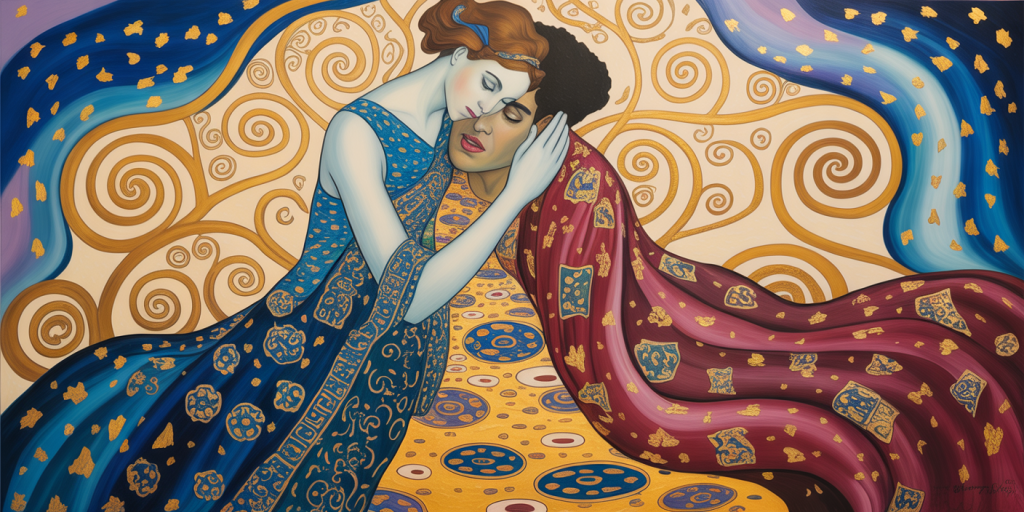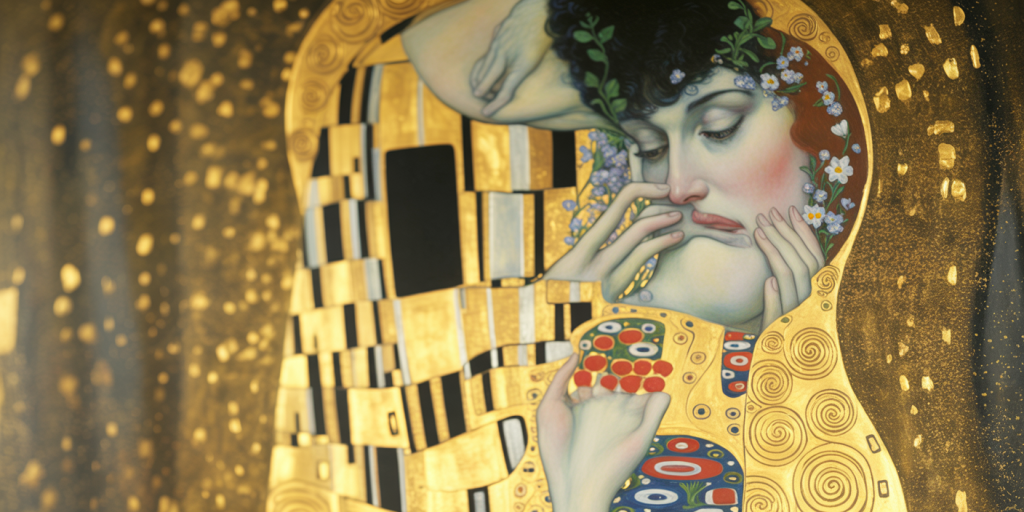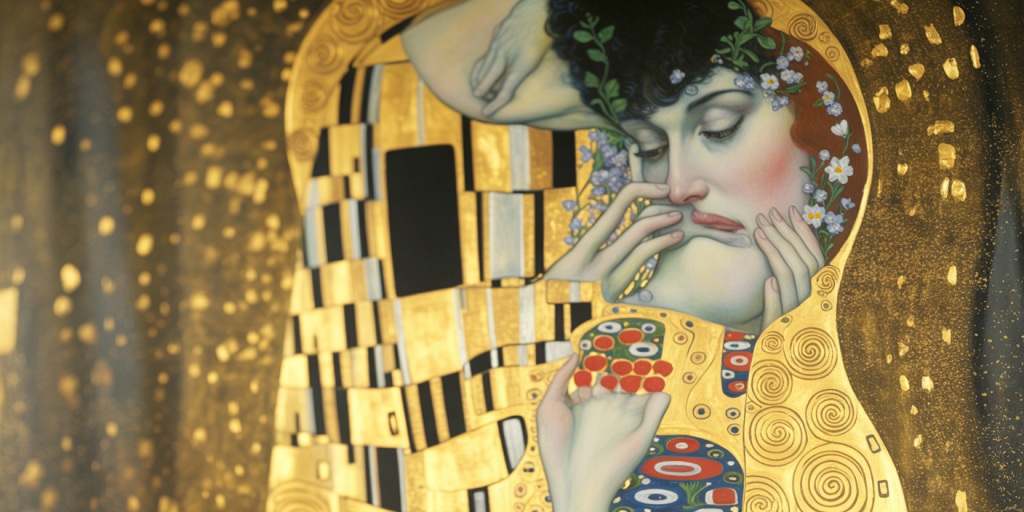Klimt and the Golden Embrace of Loving DeathKlimt
When gold whispers against the flesh of silence, a kiss is no longer an act of affection—it is an elegy. In the world of Gustav Klimt, love does not bloom in fields of innocence; it ripens in twilight, on the cusp of decay. Within his gilded tapestries, life and death entwine not as adversaries, but as old lovers reunited. There is a shimmer to his morbidity, a sensual glow to his farewells. And in that luminous ambiguity, we find the embrace of loving death—a last kiss pressed into eternity.
Klimt did not merely paint bodies; he enshrined them. Covered in sacred gold, locked in ornamental halos, his figures seem at once divine and perishable, caught between prayer and surrender. Through eyes half-closed, they do not gaze outward but dissolve inward. This is not romance in its first breath. This is passion at its last gasp.
Table of Contents
- The Gilded Breath of Farewell
- Love as a Funeral Rite
- Textures that Caress the Abyss
- The Gold that Burns and Blesses
- Faces Turned Toward Oblivion
- Death Draped in Velvet Desire
- Ornament as a Shroud of Feeling
- The-Kiss: An Altar of Surrender
- Feminine Flesh, Divine Extinction
- The Aura of Ecstasy and Mourning
- Serpentine Lines of Undoing
- Beauty Bruised by Impermanence
- When Passion Dies Wearing Gold
- Klimt and the Sacred Eroticism of Silence
- The Velvet Curtain Between Touch and Absence
- Portraits that Weep in Patterned Light
- The Lover as Witness to Vanishing
- Light That Refuses to Fade
- A Frame Etched in Goodbye
- Time Pressed into Gilded Skin
The Gilded Breath of Farewell
Klimt’s canvases pulse with a farewell rendered in metallic sighs. Gold leaf clings to the figures like the breath of something holy, or something extinguished. Each form is suspended, not in motion, but in the stillness that follows climax or collapse. The gilding does not merely embellish; it embalms.
Love as a Funeral Rite
In Klimt’s universe, love does not escape death—it performs it. The act of loving becomes ritual, a sacred descent. Lovers are mourners, clothed in brocade sorrow, caressing each other as if remembering the living from the other side. Their affection is not an offering to life, but an elegy whispered into the mouth of departure.
Textures that Caress the Abyss
Each textile, each decorative flourish in Klimt’s work touches us like fingertips tracing the edge of a grave. These textures are intimate. Mosaic patterns, swirling vines, and erotic contours mimic the gentle erosion of the self, of skin worn down not by time alone, but by longing.
The Gold that Burns and Blesses
Gold in Klimt’s hands is both halo and flame. It sanctifies and sears. It cloaks the lovers in The Kiss with reverence, yet isolates them in a sphere beyond reach. It renders them untouchable—sacred, yes, but also already lost.

Faces Turned Toward Oblivion
The eyes in Klimt’s paintings often drift closed, not in sleep, but in surrender. Even the open eyes seem veiled by something internal, as if the gaze has turned inward toward loss. It is as though they already feel the touch of soil or silk upon their lashes.
Death Draped in Velvet Desire
Desire does not scream in Klimt’s work—it sighs, low and dark like velvet. Bodies intertwine not in urgency, but in finality. His eroticism is tender, funereal. It is the warmth of hands lingering too long, of breath waiting to become wind.
Ornament as a Shroud of Feeling
The ornamental designs serve as more than beauty; they act as veils for grief, laughter, yearning. Geometries become metaphors. Spirals speak of longing unending. Squares confine the figures like coffins that glitter.
The Kiss: An Altar of Surrender
Perhaps no work embodies Klimt’s golden death-love more than The Kiss. It is not just a moment of passion; it is a mausoleum of affection. The man bends to her like a priest to a relic. Her face—eyes closed, lips softened—surrenders like a saint.

Feminine Flesh, Divine Extinction
Klimt’s women do not simply exist; they dissolve. Their bodies float in veils of gold and abstraction, their curves more hymn than anatomy. They are sacred scrolls, written in flesh, fading with each glance. Their sensuality is their sacrifice.
The Aura of Ecstasy and Mourning
Each gesture in Klimt’s figures straddles joy and lament. The tilt of a neck, the fall of a hand, all quiver with meaning. As if in every pleasure, there is a trace of parting. In every touch, a goodbye curled beneath the fingernail.
Serpentine Lines of Undoing
Klimt’s sinuous lines do not merely outline form—they unravel it. They are threads pulling us through the tapestry, leading the viewer not forward but downward, into surrender. They do not describe bodies; they dissolve them.
Beauty Bruised by Impermanence
The beauty of Klimt is a fading beauty. It is bruise-colored and light-drenched. It aches with knowledge of its own brevity. The floral motifs bloom like memorial wreaths, their petals halfway to dust.
When Passion Dies Wearing Gold
Klimt’s lovers do not rage against the dying light; they kiss beneath it. Wrapped in tapestry, they do not resist mortality—they adorn it. Passion becomes soft, weighty. It settles into the folds of the fabric like memory.
Klimt and the Sacred Eroticism of Silence
Silence is Klimt’s truest brushstroke. His figures rarely speak. Their mouths are closed, their gestures mute. But the hush between them pulses like a hidden choir. In Klimt’s silence, there is devotion. There is resignation. There is love too deep for sound.
The Velvet Curtain Between Touch and Absence
Touch in Klimt’s world is never quite complete. Even when skin meets skin, a curtain lingers—a veil of memory, of inevitability. The lovers reach, and in reaching, they lose. This is the art of almost-having.

Portraits that Weep in Patterned Light
Even Klimt’s portraits bleed with personal grief. Behind the finery, the women seem to ache. Their clothing sparkles, but their gaze empties. The light that surrounds them does not brighten—it embalms.
The Lover as Witness to Vanishing
In Klimt’s embrace, the lover does not conquer the other. He mourns her even as he holds her. His grip is not possession, but reverence. She is becoming myth before his very eyes. He is kissing the past.
Light That Refuses to Fade
The illumination in Klimt is not of the present. It is the afterglow of something lost. It stains the air like incense, lingering on skin. This is light that remembers, light that weeps.
A Frame Etched in Goodbye
Each Klimt painting feels like a frame torn from the reel of memory. Frozen in gold, it holds what cannot be kept: a moment before the fall, a caress before the vanishing. It is not a still life; it is a still death.
Time Pressed into Gilded Skin
Klimt’s genius lies in pressing time into surface. His paint becomes sediment, each layer a relic. We see not only the moment, but the mourning of it. The gold is not timeless. It is time, made sacred and heavy.
FAQ
Who was Gustav Klimt?
An Austrian Symbolist painter, Klimt (1862–1918) is known for his distinctive style merging eroticism, gold leaf, and symbolism. He was a leading figure of the Vienna Secession movement.
What is “The Kiss” and why is it so famous?
“The Kiss” (1907-1908) is Klimt’s iconic painting depicting two lovers in a golden embrace. It is celebrated for its sensuality, ornate detail, and exploration of intimacy as both ecstasy and ephemerality.
Why does Klimt use so much gold?
Gold in Klimt’s work references Byzantine mosaics, religious iconography, and eternal beauty. It elevates his subjects into the sacred, while also hinting at mortality and loss.
Is death a theme in Klimt’s work?
Yes. Klimt often explores the proximity of love and death, portraying them as intertwined forces. Death is sensual, love is elegiac.
What style is Klimt’s painting?
Klimt’s style blends Art Nouveau, Symbolism, and his own “Golden Phase.” His work features flattened perspective, bold ornamentation, and erotic figuration.
Final Reflections: When Gold Becomes Goodbye
In Klimt’s hands, gold does not glitter for vanity. It glows with grief. It clings to skin like memory, like loss that refuses to leave. His embrace is not a promise, but a prayer. A moment held, then let go. And in that holy shimmer, we understand: love does not cheat death. It dances with it. Gilded. Silent. Eternal.
